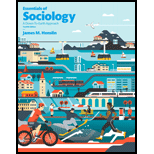
Concept introduction:
Very often, people do not agree with a social policy or practice and turn to groups that promote violent or negative ways to make change.
Explanation of Solution
Suggested response:
Radicalization is a response way beyond attempting to make change in a positive manner. It is vital to reach a person before he or she becomes radicalized. The person may want to keep his or her extreme ideas, but it is important to explain that violence is not necessary to achieve his or her goals. Consider how you have learned that this activity usually occurs when people find those with similar thoughts and they work as a group to devise a plan. Now think about how productive they could be if they put that effort toward a nonviolent action to make change. It is important that teachings such as those found in the Koran are not misinterpreted. Educating people on the idea that, as a group, they can be agents of change but that it must be done in a positive way without violence, has to occur at the very early stages of group formation.
Want to see more full solutions like this?
Chapter 11 Solutions
EBK ESSENTIALS OF SOCIOLOGY
- What activities could you use to facilitate the ending regarding the termination process in social work,? Next, what are the specific needs of your client systems that you should take into consideration as you plan for the ending working in community center? Last, what are the types of endings (natural, client-initiated, or forced) you are likely to experience at your field site?arrow_forwardUsing the 4 spheres of development ( physical, communication, thinking and social & emotional development), identify activities that will help 4-5 year students flourish in that development. make an argument for such activity. -humanized answerarrow_forwardHow can social workers effectively advocate for policy changes that address systemic issues within communities using the five approaches to change? Discuss the strategies and tactics presented in these chapters for engaging in social action and influencing policy. What challenges might social workers face in these advocacy efforts, and how can they overcome them using these five approaches?arrow_forward
- What are the key elements of successful collaborative building as described in the chapters? Discuss the role of social workers in facilitating and maintaining these collaboratives. How can social workers ensure that collaborations remain inclusive, equitable, and effective in achieving their goals? Use specific examples from working at a community center.arrow_forwardAlso, about how medical interactions connect to aspects of courtroom trials and 911 conversation. Treatment Recommendations The transcript below is the entire diagnosis and treatment phase of a primary care encounter involving a mom and her sick daughter who has had symptoms of sore throat and fever. Address these two questions regarding the doctor’s treatment recommendations.Question 1: Affirmative treatment recommendations:Focus on the doctor’s affirmative recommendations, which are mainly for over-the-counter medications (not prescriptions), in lines 71-72, 78-79, 82-86, and 123-134 (in boldface). • 1a: Using the recommendation formats sketched by Heritage in his last lecture(pronouncement/proposal/suggestion/offer/assertion), which format or formats is the doctor using? Explain.• 1b: Given your answer to 1a, how would you characterize the doctor’s overall style of recommendation? Are they relatively authoritative or relatively collaborative in their approach, and to what…arrow_forwardAlso do not forget about how medical interactions connect to aspects of courtroom trials and 911 conversation.arrow_forward
- Also do not forget about how medical interactions connect to aspects of courtroom trials and 911 conversation.arrow_forwardExplain the historical background of rape. Please include references.arrow_forwardWhat constitutes sexual harassment, and to what extent should organizations be held accountable for the actions of their members or employees?arrow_forward
- Around 1900, about what percentage of people in North America lived on farms? 10% 30% 50% 70%arrow_forwardWhich of the following best describes the concept of cultural pluralism? People of different ethnic backgrounds gradually become integrated into the dominant culture of a country People of different ethnic backgrounds live peacefully together in towns and communities, but maintain their distinctive traditions and culture Traditions of immigrants from different ethnic backgrounds become part of the dominant culture of a country People of different ethnic backgrounds maintain their culture and traditions by living apart from othersarrow_forwardCriminological theory drunkbdriving support appropriatenessarrow_forward
 Social Psychology (10th Edition)SociologyISBN:9780134641287Author:Elliot Aronson, Timothy D. Wilson, Robin M. Akert, Samuel R. SommersPublisher:Pearson College Div
Social Psychology (10th Edition)SociologyISBN:9780134641287Author:Elliot Aronson, Timothy D. Wilson, Robin M. Akert, Samuel R. SommersPublisher:Pearson College Div Introduction to Sociology (Eleventh Edition)SociologyISBN:9780393639407Author:Deborah Carr, Anthony Giddens, Mitchell Duneier, Richard P. AppelbaumPublisher:W. W. Norton & Company
Introduction to Sociology (Eleventh Edition)SociologyISBN:9780393639407Author:Deborah Carr, Anthony Giddens, Mitchell Duneier, Richard P. AppelbaumPublisher:W. W. Norton & Company The Basics of Social Research (MindTap Course Lis...SociologyISBN:9781305503076Author:Earl R. BabbiePublisher:Cengage Learning
The Basics of Social Research (MindTap Course Lis...SociologyISBN:9781305503076Author:Earl R. BabbiePublisher:Cengage Learning Criminalistics: An Introduction to Forensic Scien...SociologyISBN:9780134477596Author:Saferstein, RichardPublisher:PEARSON
Criminalistics: An Introduction to Forensic Scien...SociologyISBN:9780134477596Author:Saferstein, RichardPublisher:PEARSON Sociology: A Down-to-Earth Approach (13th Edition)SociologyISBN:9780134205571Author:James M. HenslinPublisher:PEARSON
Sociology: A Down-to-Earth Approach (13th Edition)SociologyISBN:9780134205571Author:James M. HenslinPublisher:PEARSON Society: The Basics (14th Edition)SociologyISBN:9780134206325Author:John J. MacionisPublisher:PEARSON
Society: The Basics (14th Edition)SociologyISBN:9780134206325Author:John J. MacionisPublisher:PEARSON





